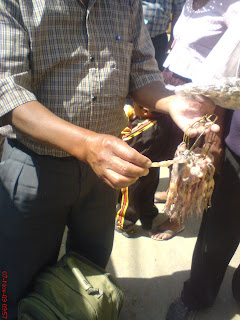
Just a couple of days after our last update in the blog we had news about Telmatobius. We received a call from our colleague herpetologist telling us that somebody was selling frogs in the local market here in Cochabamba city, that the species was Telmatobius culeus a critically endangered species (http://www.iucnredlist.org/apps/redlist/details/57334/0).
It is amazing how easy is to have this kind of situations where a critically endangered species that have to be protected now you can find in a local market and buy alive or dead like medicine or that can help you with you capacity to learn….

This man told that he is from Peru and if we want more frogs we can ask him (gave us the cell phone) and he can provide us the size we want and the species we want because he knows some other places with frogs in Peru… the interesting thing is that in our study area the local community told us that Peruvians go to those communities and buy the frogs for just a couple of bolivianos (local money) and they take entire buckets, sometimes full with frogs.
It is important to try stop this situation before they expand this, because it is not a traditional  use of the species, this use it was recently introduced in the country and now it is in Cochabamba city, about at least 12 hours from Titicaca lake, so it is not a occasional activity like it says in this article http://www.la-razon.com/Versiones/20090705_006779/nota_277_839363.htm .
use of the species, this use it was recently introduced in the country and now it is in Cochabamba city, about at least 12 hours from Titicaca lake, so it is not a occasional activity like it says in this article http://www.la-razon.com/Versiones/20090705_006779/nota_277_839363.htm .
Now we have another thing to be aware and also we need to start working closely with the government, local authorities and media to try to protect the species. (we want to thank Oliver Quinteros that provided the pictures)






